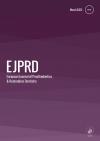European Journal of Prosthodontics and Restorative Dentistry
Evaluation of New Alkasite Based Restorative Material for Restoring Non Carious Cervical LesionsRandomized Controlled Clinical Trial
Abstract
Two different restoration materials, an alkasite-based resin composite and a resinmodified glass ionomer cement were used to assess restoration of non-carious cervical dental lesions. This split mouth randomized controlled trial included 40 patients. After randomization both sides of the dental arch were restored with either an alkasite-based (Cention N, Ivoclar Vivadent) or a resin-modified glass ionomer cement (Voco GmbH) restoration. The placed fillings were evaluated by blinded additional operators 1, 6 months and 1 year after to the USPHS criteria (retention, marginal integrity and discoloration, anatomical form and secondary caries). Data were analyzed using Kendall’s Coefficient of Concordance test and Chi-square tests using SPSS software (SPSS Inc., Version 20) (P=0.05). As for retention and anatomic form both materials performed similar after one month. However, the retention and anatomic form for alkasite based restorative
Cention showed significantly better results after 6 months (p=0.013/p=0.003) and one year (p=0.026/p=0.008). The resin modified glass ionomer restoration showed higher discoloration after 6 months (p=0.025) and one year (p=0.018), while Cention performed better regarding marginal integrity at all time intervals. No secondary caries occurred. Alkasite based restorative materials displayed superior technical, mechanical and aesthetical performance in a follow-up period of one year and can therefore be recommended as an alternative to resin-modified glass ionomer cements.
Keywords
Adhesion
Resin-Modified Glass Ionomer Cement
Alkasite-Based
Non-Cervical Lesion
Restoration Material
Authors
Nidambur Vasudev Ballal, Prateek Jalan, Namith Rai, Nadin Al-Haj Husain, Mutlu Özcan
Articles from this issue
 Free Access
Free Access No Access
No Access Full Access
Full Access


